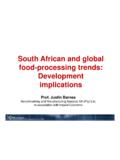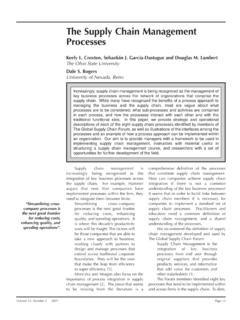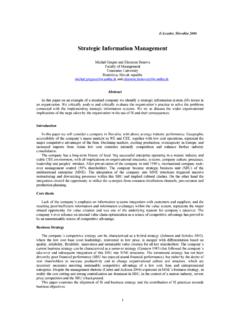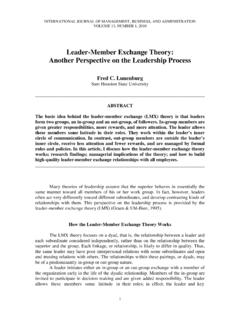Transcription of Rising Food Prices - OECD
1 Rising food Prices CAUSES AND CONSEQUENCES Rising food Prices : CAUSES AND CONSEQUENCES OECD 2008 2 EXECUTIVE SUMMARY Recent steep price increases of major crops (cereals, oilseeds) were triggered by a combination of production remaining somewhat below trend and strong growth of demand. A low and declining level of stocks has added to the price rise, as has probably a significant increase in investments in agricultural derivative markets. The OECD-FAO Agricultural Outlook expects Prices to come down again, but not to their historical levels. On average over the coming ten year period, Prices in real terms of cereals, rice and oilseeds are projected to be 10% to 35% higher than in the past decade. The acute price hike adds to inflationary pressures in developed countries. Poor consumers in developing countries, and food importing developing countries overall, will have to spend an even higher share of their limited income on food .
2 In the short term, humanitarian aid is required, where appropriate in the form of cash or vouchers so as to strengthen, rather than undermine domestic markets in recipient countries. In the medium term, there is a need to foster growth and development in poor countries, to improve the purchasing power of food buyers. Agricultural trade policies require further reform in order to ensure an effective supply response. Investments in productivity growth, particularly in less developed countries, should also strengthen the supply side of global agriculture. On the demand side, policies that encourage increased production and use of biofuels from agricultural commodity feed stocks warrant review. Introduction World Prices of wheat, coarse grains, rice and oilseed crops all nearly doubled between the 2005 and 2007 marketing years and continued Rising in early 2008.
3 These increases in agricultural commodity Prices have been a significant factor driving up the cost of food and have led to a fuller awareness and a justifiably heightened concern about problems of food security and hunger, especially for developing countries. The causes of this price spike are complex and due to a combination of mutually reinforcing factors, including droughts in key grain-producing regions, low stocks for cereals and oilseeds, increased feedstock use in the production of biofuels, rapidly Rising oil Prices and a continuing devaluation of the US dollar, the currency in which indicator Prices for these commodities are typically quoted. This turmoil in commodity markets has occurred against the backdrop of an unsettled global economy, which in turn appears to have contributed to a substantial increase in speculative interest in agricultural futures markets.
4 Tight market conditions for essential agricultural commodities pose policy challenges for national governments as well as for international organisations. In order to take the right policy decisions, we need to understand what caused the current price spike, what the implications may be for Prices and price volatility in the future, and how various countries and members of society may be affected. This note aims to improve this understanding and thereby to contribute to sound policy formulation. Rising food Prices : CAUSES AND CONSEQUENCES OECD 2008 3 Are food price hikes unprecedented? The commodity price developments witnessed recently are certainly unusual when viewed from the perspective of the last decade or so, but less so when seen in a longer historical context. Figure 1 shows the evolution in nominal and in real terms of annual average world Prices of wheat, coarse grains, rice and oilseeds from 1971 to 2007 with projections from 2008 to 2017.
5 While spot Prices for April-May 2008 are not shown, for these commodities price levels greatly exceeded the expected annual average for 2008. Two points are clear: first, agricultural commodity markets are notoriously volatile; second, the current price spike is neither the only nor even the most significant one to occur in the last forty years. Figure 1. food commodity price trends 1971 2007, with projections to 2017 0100200300400500600700197119731975197719 7919811983198519871989199119931995199719 99200120032005200720092011201320152017 USD/tNominalRealWheat0501001502002503003 5040045050019711973197519771979198119831 9851987198919911993199519971999200120032 005200720092011201320152017 USD/tNominalRealCoarse Grains0200400600800100012001971197319751 9771979198119831985198719891991199319951 9971999200120032005200720092011201320152 017 USD/tNominalRealOilseeds0200400600800100 0120014001600197119731975197719791981198 3198519871989199119931995199719992001200 32005200720092011201320152017 USD/tNominalRealRice Note: Real Prices deflated by USA GDP deflator 2007 = 1.
6 Source: OECD-FAO Agricultural Outlook, 2008-2017 Rising food Prices : CAUSES AND CONSEQUENCES OECD 2008 4 It is also important to recall that Prices for meat and poultry have seen no or modest increases during this same period. There have been substantial increases in the Prices of dairy products, at least in part due to recent policy developments, though more recently Prices have again declined somewhat. As the international debate has focused on the implications of increases in Prices for crop markets this note focuses primarily on Prices for cereals and oilseeds. How can the current price spike be explained? Prices rise when markets get tight. Between 2005 and 2007 there were coinciding spells of unfavourable weather in major producing regions in the world, pushing crop yields in those areas below long term average levels.
7 World cereal output in 2007 was just 3% larger than in 2005 while there was a decline in overall oilseeds output; nevertheless, vegetable oil production rose by 7% due to rapid growth in palm oil output. At the same time, there was strong demand growth. Demand for wheat and coarse grains grew almost twice as much as did production, and demand for vegetable oil increased two percentage points more than output. More than half of the increase in use of both coarse grains and vegetable oil was due to higher use in the biofuels industry. Use of cereals and vegetable oil for food also continued to grow, as did cereal use for feed. This food and feed demand growth came primarily from countries outside the OECD area and accounted for the remaining nearly 50% of the total increase in demand. The production shortfall, relative to trend, would in itself have been enough to send Prices higher, although under normal conditions stocks would have buffered the market and dampened the price rise.
8 But stocks were already low and they kept declining in 2006 and 2007 because of bad weather and low yields in major exporting countries. Supply shortfalls, the absence of a sufficient buffer, the continued increase in food and feed use, and the high growth in relatively price-insensitive demand for biofuels all coincided to make the price increases exceptional. More recently, there has also been a significant increase in investments in agricultural derivative markets from non-traditional sources, whether for portfolio diversification or speculation. It is likely that this has contributed to the rise in short term futures Prices and is an additional factor in the current spike in spot market Prices . Some of the factors behind the current price hike are transitory while others may be more permanent. Making that distinction is an important ingredient in projecting market developments over the coming ten year period, as is done in the OECD-FAO Agricultural Outlook.
9 This differentiation is also important in designing good policy to deal with the implications of the price increases. What factors will shape future Prices and price volatility? The recent negative yield shocks in key agricultural commodity producing regions that have contributed to price increases should be viewed as temporary. Barring any underlying climate change or water constraints that could lead to permanent reductions in yield, normal higher output can be expected in the very short term. Macroeconomic conditions that favour economic growth, increases in purchasing power, and stronger demand for agricultural commodities are expected to continue, at least for many non-OECD economies. This is a permanent factor in future price determination, but not a new one: strong GDP growth in developing countries has been a feature of commodity markets for many years.
10 Thus, this factor should slow the decline in real Prices in the future, but not lift average Prices to permanently higher levels. Rising food Prices : CAUSES AND CONSEQUENCES OECD 2008 5 The oil price, and energy Prices more generally, is a critically important contributing factor to the increase in production costs for agricultural commodities and food and ultimately in the market Prices for these goods. Price projections discussed here reflect the widely held belief that the oil price increases are permanent, lifting future Prices to higher average levels. Feedstock demand for biofuel production is expected to increase further, albeit at a slower rate than in the past three years, and under current policy settings appears to represent a permanent factor in price formation. Unlike strong income growth in developing countries, this is a new source of demand which is seen as one of the factors lifting Prices to higher average levels in the future.

















